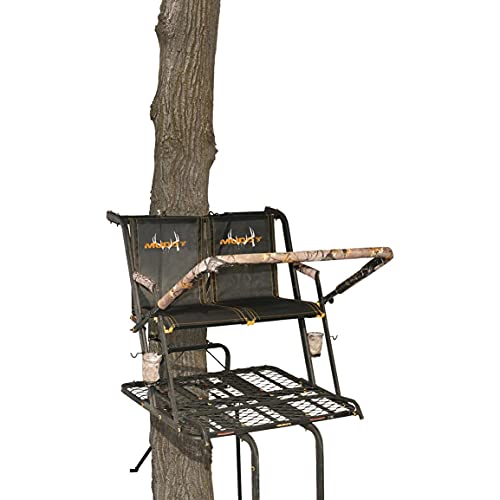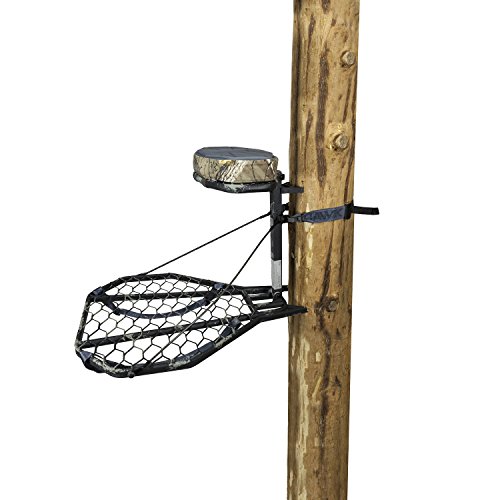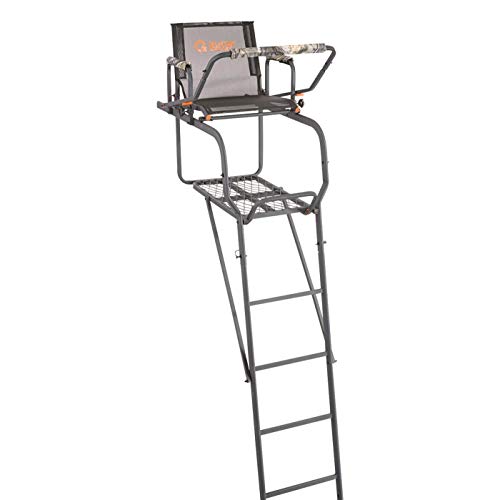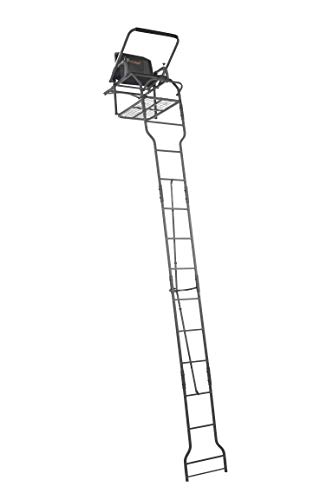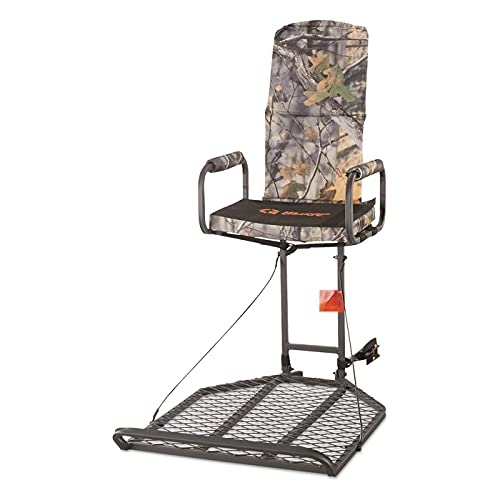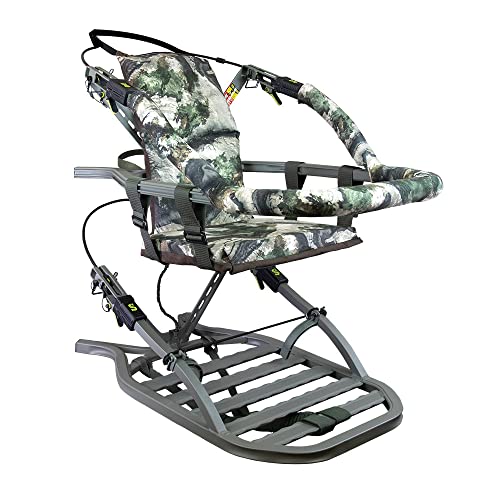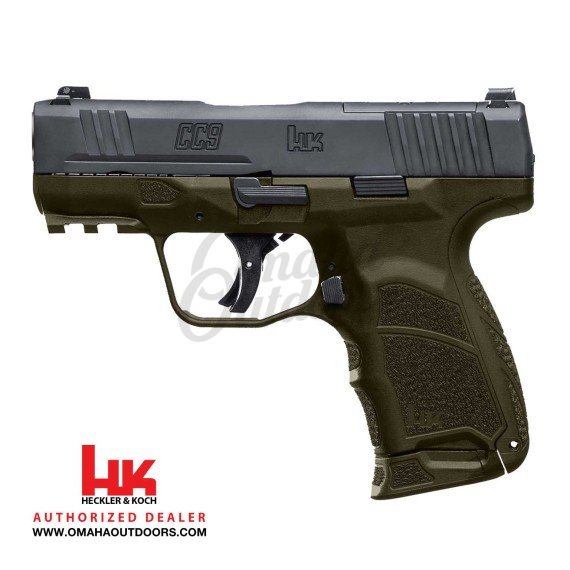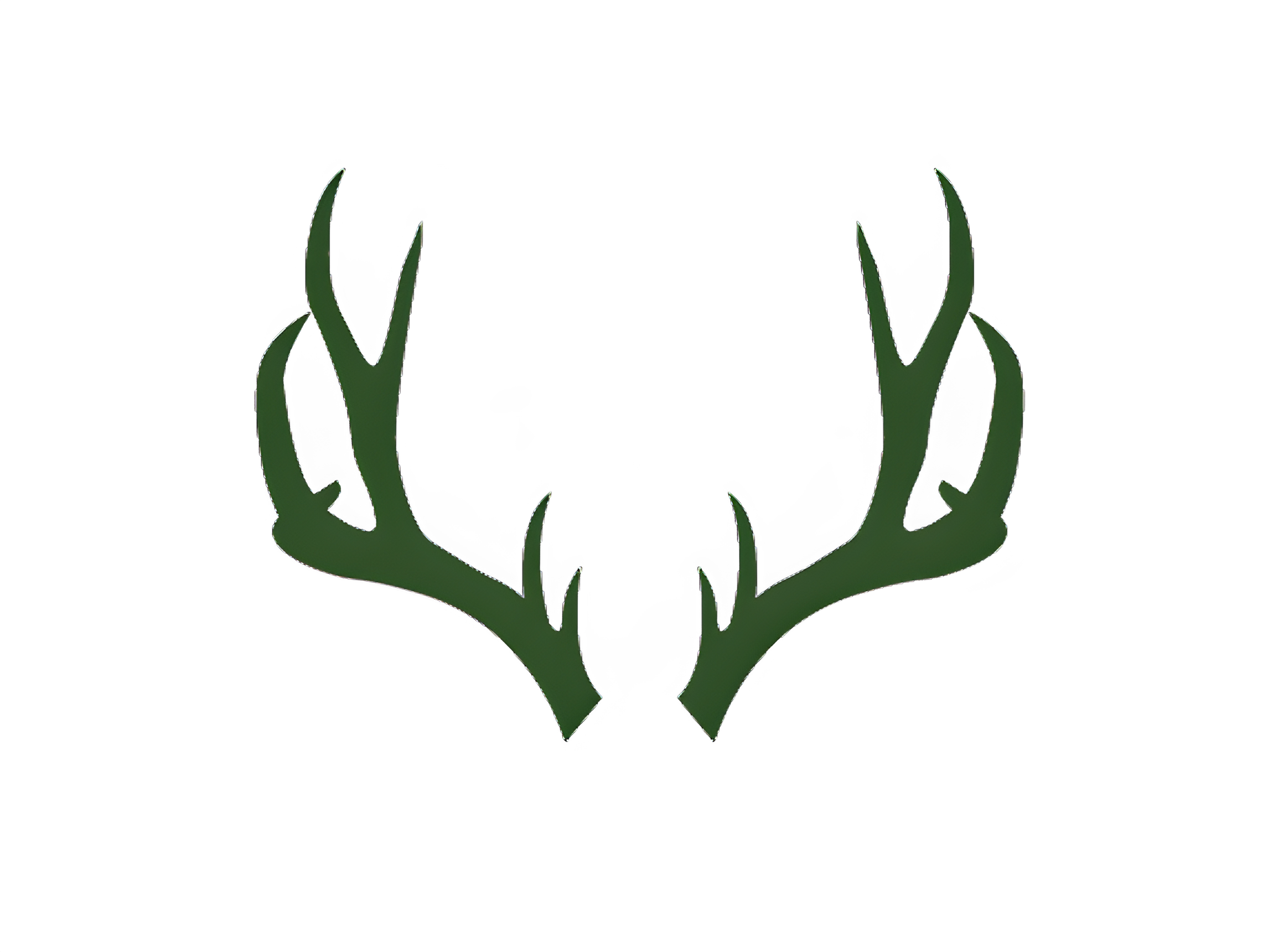Tree stands are a popular choice among hunters during deer season, but they can also pose significant risks for accidents and falls. According to statistics, tree stand falls account for the largest number of hunting-related injuries and deaths in the United States. It is crucial to prioritize safety when using tree stands to prevent deadly falls. This article will provide a comprehensive treestand safety checklist and highlight essential gear that can help hunters stay secure aloft.

Key Takeaways
- Tree stand falls are a leading cause of hunting-related injuries and deaths in the US.
- A treestand safety checklist can help prevent accidents and promote hunting well-being.
- Choosing the right tree, inspecting safety equipment, using a safety harness, and maintaining three points of contact are key practices for treestand safety.
- Using a haul line for gear and wearing proper footwear are additional measures to enhance treestand safety.
- Prioritizing safety and following the treestand safety checklist can ensure a safe and successful bowhunting season.
Tree Stand Accidents Statistics
Tree stand accidents are more common than one might think, with statistics revealing alarming numbers. According to a study conducted by the Wisconsin DNR, tree stand falls, rather than firearm accidents, are the primary cause of hunting-related injuries and deaths in the US. Approximately 28% of archers and 13% of firearm users have experienced falls or near-falls from tree stands. Additionally, about 1 in 3 people who hunt from a stand will encounter a fall resulting in injury. These statistics emphasize the importance of treestand safety to prevent accidents and promote hunting well-being.
https://www.youtube.com/watch?v=byXHuNU8DkE
Common Causes of Tree Stand Accidents
Understanding the common causes of tree stand accidents is crucial for preventing them. When analyzing various accidents involving tree stands, it was found that most incidents occur during climbing up or down and installing/removing the stands. Several factors contribute to these accidents:
- Incorrectly placing or using equipment
- Mistakes during climbing
- Using damaged equipment
- Lack of knowledge about equipment
- Excessive wear or stress on equipment
By being aware of these common causes, hunters can take appropriate precautions to avoid accidents. Proper use of equipment, careful climbing techniques, regular equipment maintenance, and gaining knowledge about safety protocols can significantly reduce the risk of falls and injuries. It is important to prioritize safety at all times when hunting from elevated stands.
| Common Causes | Preventive Measures |
|---|---|
| Incorrectly placing or using equipment | Follow manufacturer instructions, ensure proper installation and use, regularly inspect and maintain equipment |
| Mistakes during climbing | Adhere to proper climbing techniques, maintain three points of contact, use a safety harness at all times |
| Using damaged equipment | Regularly inspect and repair or replace damaged equipment, do not use equipment with visible signs of wear or damage |
| Lack of knowledge about equipment | Seek proper training on equipment usage and safety procedures, stay informed about the latest industry standards |
| Excessive wear or stress on equipment | Follow recommended weight limits, avoid overloading stands and equipment, replace worn or weakened components |
By addressing these common causes and implementing preventive measures, hunters can significantly reduce the risk of accidents while using tree stands. Remember, prevention is key to ensuring a safe and enjoyable hunting experience.
Choosing the Right Tree for Tree Stand Hunting
When it comes to tree stand hunting, choosing the right tree is a crucial step for ensuring treestand safety. The tree you select should be healthy, sturdy, and capable of supporting your weight. Additionally, it should be strategically positioned within cover, providing the necessary camouflage for a successful hunt. To enhance stability, it is recommended to opt for a tree with rough, scaly bark, such as oak, maple, or pine. The straps of your tree stand can dig into the bark, providing an added layer of stability and security. Take the time to carefully assess and select the appropriate tree, as this decision directly impacts your safety during your hunting excursion.
Make sure to inspect the tree for signs of damage or weakness, such as rot, cracks, or leaning. These deformities can compromise your safety and increase the risk of accidents. It is advisable to avoid trees with visible damage and instead choose a tree that is structurally sound and shows no evidence of decay.
Key Considerations for Choosing the Right Tree
- Health and sturdiness: Inspect the tree for signs of disease, rot, or damage. Choose a tree that is strong and capable of supporting your weight.
- Camouflage: Select a tree that provides adequate cover and blends well with the surrounding environment to avoid detection by game.
- Bark texture: Look for trees with rough, scaly bark like oak, maple, or pine, as this type of bark helps the tree stand straps grip securely.
By selecting a suitable tree that aligns with these criteria, you can enhance your treestand safety and maximize your chances of a successful hunting experience.
Deluxe Hang-On Tree Stand Chair for Hunting, Camo
Stay comfortable and concealed while hunting with this Deluxe Hang-On Tree Stand Chair in Camo print
Product information
$109.99
Product Review Score
4.77 out of 5 stars
37 reviewsProduct links
Inspecting Safety Equipment
Regular inspection of safety equipment is vital for treestand safety. Before each use, hunters should thoroughly inspect their tree stand, harness, and all related components. This includes checking for missing components, broken or loose parts, intact straps and lines, secure steps, and a well-fitting and undamaged harness. Inspecting safety equipment ensures that it is in good condition and reduces the risk of accidents due to equipment failure.
Using a Safety Harness
Using a safety harness is a non-negotiable aspect of treestand safety. It is crucial to always wear a full-body safety harness when climbing, setting up, scouting, or hunting from a tree stand.
Unfortunately, studies have shown that a significant percentage of hunters do not consistently use fall protection harnesses. This neglect can have severe consequences. Wearing a safety harness significantly reduces the risk of falling and can prevent severe injuries or even fatalities.
To prioritize personal safety while hunting from tree stands, it is essential to make the use of safety harnesses a top priority. Don't compromise on protection - always wear a safety harness when using a tree stand to ensure fall protection and treestand safety.

The Importance of Safety Harnesses
“A safety harness is the lifeline that connects a hunter to the tree. It is the most critical piece of equipment when it comes to treestand safety.”
Using a safety harness offers several key benefits:
- Prevents Falls: A safety harness provides fall protection by keeping the hunter securely connected to the tree stand.
- Reduces Injuries: In the event of a fall, wearing a safety harness minimizes the risk of severe injuries or even fatalities.
- Promotes Confidence: With a safety harness in place, hunters can focus on their hunting experience without worrying about falling.
- Ensures Peace of Mind: Wearing a safety harness allows hunters to enjoy their time in the tree stand with the assurance of being protected from falls.
Tips for Using a Safety Harness
To use a safety harness effectively and maximize treestand safety, consider the following tips:
- Choose the Right Harness: Select a safety harness that fits well and is designed for treestand hunting. Ensure it meets industry safety standards.
- Properly Wear and Adjust: Follow the manufacturer's instructions to wear and adjust the safety harness correctly for a secure fit.
- Inspect Regularly: Before each use, inspect the safety harness for any signs of wear, damage, or malfunction. Replace any worn-out or defective parts.
- Secure to the Tree: Use a sturdy, reliable tether system to connect the safety harness to the tree. Avoid using damaged or worn-out straps or ropes.
- Practice Treestand Safety: Adhere to all treestand safety practices, including maintaining three points of contact, using a haul line for gear, and wearing proper footwear.
Maintaining Three Points of Contact
Maintaining three points of contact when climbing a ladder or steps of a tree stand is a critical safety practice. By always having two hands and one foot or one hand and two feet on the ladder or steps at all times, hunters can ensure stability and reduce the risk of slipping or falling. Rushing or making sudden movements while climbing can increase the chances of accidents, so it's important to proceed slowly and deliberately.
When ascending or descending from a tree stand, hunters should prioritize safety by keeping three points of contact with the ladder or steps. This practice provides a stable base of support and helps maintain balance throughout the process. By following this principle, hunters can navigate the climb with confidence and minimize the potential for accidents.
A common mistake hunters make is relying on their upper body strength alone, neglecting to establish a solid footing. This can lead to instability and falls. By spreading the weight evenly and utilizing three points of contact, hunters distribute their weight across multiple anchor points, significantly reducing the risk of losing balance or slipping.
Tree stand climbing involves navigating various obstacles, such as branches or uneven surfaces. By maintaining three points of contact, hunters can adapt to these challenges effectively and safely. This practice enables hunters to adjust their grip or foot placement while still having a secure hold on the ladder or steps, ensuring a steady ascent or descent.
Remember, maintaining three points of contact is an essential treestand safety practice that guarantees stability and reduces the risk of accidents. By proceeding with caution, using deliberate movements, and always having two hands and one foot or one hand and two feet on the ladder or steps, hunters can confidently climb tree stands and focus on the thrill of bowhunting.
Summit Treestands Viper Pro SD in Mossy Oak
Summit Treestands Viper Pro SD in Mossy Oak is the ultimate hunting stand for stealthy success in the wild
Product information
$479.99 $451.14
Product Review Score
4.15 out of 5 stars
177 reviewsProduct links
Using a Haul Line for Gear
Hunters understand the importance of carrying essential gear when heading up to a treestand. However, attempting to climb into a tree stand while lugging gear can be a recipe for disaster. That's where a haul line comes in handy. A haul line is a simple yet effective tool that allows hunters to safely raise or lower their equipment to and from the treestand.
By utilizing a haul line, hunters can avoid carrying heavy or bulky gear while climbing. This not only prevents unbalancing but also significantly decreases the risk of falls. It ensures that both hands are free for maintaining three points of contact on the ladder or steps, promoting stability and reducing the chances of accidents.
When using a haul line, it's essential to practice proper firearm safety. Before attaching the firearm to the line, ensure that it is unloaded and that the action is kept open. This precaution minimizes the risk of accidental discharge and promotes safe handling of firearms in treestand situations.
Hunters should also consider using a haul line for packing other essential treestand gear, such as backpacks, bow cases, or other equipment. By relying on a haul line to transport their gear, hunters can maintain better control and balance while climbing up to or down from the treestand.
Remember, the key to a safe and successful hunting experience is taking appropriate precautions and using the right tools. Incorporating a haul line into your treestand gear setup is a smart and responsible choice that enhances both convenience and safety.
Proper Footwear for Treestand Safety
Wearing appropriate footwear is a critical aspect of ensuring treestand safety. When it comes to climbing into the tree stand, having the right pair of shoes can make a significant difference in preventing accidents. One of the key features to look for in footwear is non-slip or high-traction soles. These soles provide excellent grip and stability, minimizing the risk of slipping or losing balance on the ladder or steps.
Investing in proper footwear designed specifically for outdoor activities and rugged terrains can greatly enhance treestand safety. Look for hunting boots or hiking shoes that offer durable construction, ankle support, and reliable traction. Many reputable brands, such as Danner, Rocky, and Irish Setter, offer footwear options tailored for the needs of hunters.
By wearing shoes with non-slip soles, hunters can have a firm hold on the ladder or steps while climbing into the tree stand. This helps reduce the chances of accidents caused by slipping or mishaps during ascent. Remember, treestand accidents can lead to severe injuries, and prioritizing safety with proper footwear is an essential precaution.
When selecting footwear, opt for models that are comfortable and well-fitted. It is advisable to try on shoes before purchasing to ensure a proper fit and avoid discomfort while in the tree stand. Additionally, consider the weather conditions and terrain you will be hunting in, as these factors can impact footwear requirements.
Do not underestimate the importance of proper footwear for treestand safety. Your choice of shoes can significantly contribute to maintaining stability and reducing the risk of accidents. Stay grounded with non-slip soles, and enjoy a safer hunting experience from your tree stand.
| Benefits of Proper Footwear for Treestand Safety |
|---|
| Enhanced grip and stability: Non-slip soles provide excellent traction, minimizing the risk of slipping and falling when climbing into the tree stand. |
| Reduced accidents: Wearing appropriate footwear designed for outdoor activities and rugged terrains can greatly reduce the chances of accidents caused by footwear-related issues. |
| Durable construction: Proper hunting or hiking footwear offers durability, ensuring the shoes can withstand the demands of hunting in various environments. |
| Ankle support: Many hunting boots and hiking shoes provide excellent ankle support, helping to prevent injuries and maintain stability while climbing. |
| Comfort and fit: Choosing well-fitted footwear that is comfortable to wear for extended periods can contribute to a more enjoyable and safer hunting experience. |
Conclusion
Safety should always be the top priority when it comes to hunting from tree stands. By following a thorough treestand safety checklist, investing in essential gear, and adhering to safety practices, hunters can significantly reduce the risk of accidents and falls.
Key elements for treestand safety include using a safety harness, inspecting equipment before each use, maintaining three points of contact while climbing, using a haul line for gear, and wearing proper footwear. These measures ensure a safe and successful bowhunting season while minimizing the risks associated with tree stand accidents.
Remember, treestand accidents can be deadly, but with the right precautions and the use of appropriate gear, hunters can enjoy their time aloft with confidence and peace of mind. Prioritize safety and make treestand safety a fundamental part of your bowhunting routine.
FAQ
What is a treestand safety checklist?
A treestand safety checklist is a comprehensive list of safety measures and gear that hunters should adhere to and utilize when using a treestand. It includes inspecting equipment, wearing a safety harness, maintaining three points of contact, using a haul line for gear, and wearing proper footwear, among other safety practices.
Why are tree stand accidents statistics important to know?
Tree stand accidents statistics provide valuable insights into the prevalence and severity of accidents related to hunting from tree stands. By understanding these statistics, hunters can better appreciate the importance of treestand safety and take the necessary precautions to avoid accidents and injuries.
What are the common causes of tree stand accidents?
Common causes of tree stand accidents include incorrectly placing or using equipment, mistakes during climbing, using damaged equipment, lack of knowledge about equipment, and excessive wear or stress on equipment. Being aware of these causes can help hunters take appropriate preventive measures.
How do you choose the right tree for tree stand hunting?
When choosing a tree for tree stand hunting, it is essential to consider factors such as tree health, sturdiness, straightness, and its suitability for camouflage. Trees with rough, scaly bark like oak, maple, or pine are recommended, as the straps can dig into the bark for added stability.
Why is inspecting safety equipment important for treestand safety?
Regular inspections of safety equipment, including the tree stand, harness, and related components, is crucial to ensure that they are in good condition and functioning properly. Inspecting safety equipment before each use reduces the risk of accidents and injuries resulting from equipment failure.
Why is using a safety harness important for treestand safety?
Using a safety harness is essential for treestand safety as it significantly reduces the risk of falling and can prevent severe injuries or fatalities. Unfortunately, many hunters do not consistently use fall protection harnesses, even though they are crucial for personal safety while hunting from tree stands.
What does it mean to maintain three points of contact?
Maintaining three points of contact means always having two hands and one foot, or one hand and two feet, on the ladder or steps of a tree stand while climbing. This practice ensures stability and reduces the risk of slipping or falling during ascent or descent.
Why should a haul line be used for gear instead of carrying it while climbing into a tree stand?
Using a haul line to raise or lower equipment to the tree stand is safer than carrying it while climbing. It helps maintain balance, reduces the risk of falls, and prevents equipment from getting tangled or unbalanced. Firearms should be unloaded and actions kept open when using a haul line to transport them, practicing proper firearm safety at all times.
Why is proper footwear important for treestand safety?
Wearing appropriate footwear with non-slip or high-traction soles is crucial for treestand safety. Good footwear provides a firm grip on the ladder or steps, preventing slipping and maintaining stability while climbing into the tree stand and moving around. Investing in proper footwear designed for outdoor activities and rugged terrains is essential for safety.
What is the importance of treestand safety checklists and gear for bowhunters?
Treestand safety checklists and gear are of utmost importance for bowhunters as they help prevent accidents and deadly falls. By following a comprehensive treestand safety checklist and using essential gear like safety harnesses, inspecting equipment, maintaining three points of contact, using a haul line for gear, and wearing proper footwear, bowhunters can ensure a safe and successful hunting season while minimizing risks.
Source Links
